AUDI R8 SPYDER 2011 Owners Manual
Manufacturer: AUDI, Model Year: 2011, Model line: R8 SPYDER, Model: AUDI R8 SPYDER 2011Pages: 244, PDF Size: 59.74 MB
Page 101 of 244

Driving Safely
General notes
Safe driving habits
Please remember -safety first!
This chapter contains important information,
tips, instructions and warnings that you need
to read and observe for your own safety, the
safety of your passengers and others . We have
summarized here what you need to know
about safety belts, airbags, child restraints as
well as child safety. Your safety is for us
priori
ty number 1.
Always observe the information
and warnings in this section - for your own
safety as well as for that of your passengers.
The information in this section applies to all
model versions of your vehicle . Some of the
features described in this sections may be
standard equipment on some models, or may
be optional equipment on others. If you are
not sure, ask your authorized Audi dealer.
A WARNING
- Make certain that you follow the instruc
tions and heed the WARNINGS in this
Manual. It is in your interest and in the
interest of your passengers.
- Always keep the complete owner's litera
ture in your Audi when you lend or sell
your vehicle so that this important infor
mation will always be available to the
driver and passengers.
- Always keep the owner's literature handy
so that you can find it easily if you have
questions.
Safety equipment
The safety features are part of the occupant
restraint system and work together to help
reduce the risk of injury in a wide variety of
accident situations .
Your safety and the safety of your passengers
should not be left to chance. Advances in
technology have made a variety of features
available to help reduce the risk of injury in an
Driving Safely 99
accident. The following is a listing of just a
few of the safety features in your Audi:
- sophisticated safety belts for driver and all
passenger seating positions,
- safety belt pretensioners ,
- front airbags,
- knee airbags,
- side airbags in the seats
- adjustable head restraints,
- adjustable steering column.
These individual safety features can work to
gether as a system to help protect you and
your passengers in a wide range of accidents.
These features cannot work as a system if
they are not always properly adjusted and
properly used!
Safety is everybody's responsibility!
Important things to do before driving
Safety is everybody's job! Vehicle and occu
pant safety always depends on the informed and careful driver.
For your safety and the safety of your passen
gers,
before driving always:
~ Make sure that all lights and signals are op
erating correctly .
~ Make sure that the tire pressure is correct.
~ Make sure that all windows are clean and af
ford good visibility to the outside.
~ Secure all luggage and other items carefully
r=:> page 70.
~ Make sure that nothing can interfere with
the pedals.
~ Adjust front seat, head restraint and mirrors
correctly for your height .
~ Instruct passengers to adjust the head re
straints according to their height .
~ Make sure to use the right child restraint
correctly to protect children¢
page 138,
Child Safety.
~ Sit properly in your seat and make sure that
your passengers do the same¢
page 66,
Seats and storage. .,..
•
•
Page 102 of 244

100 Driving S afel y
• Fasten your safety be lt and wear it properly .
Also instruct your passengers to fasten their
safety belts properly ¢
page 109.
What impairs driving safety?
Safe driving is directly related to the condi
tion of the vehicle, the driver as well as the
driver 's ability to concentrate on the rood
without being distracted.
The driver is responsible for the safety of the
vehicle and all of its occupants. If your ability
to drive is impaired, safety risks for everybody
in the vehicle increase and you also become a
hazard to everyone else on the road ¢
.&,.
Therefore:
• Do not let yourself be distracted by passen
gers or by using a cellular telephone .
• NEVER dr ive when your dr iving ability is im
paired (by medicat ions, alcohol, drugs, etc.) .
• Observe all traffic laws, rules of the road
and speed limits and plain common sense.
• ALWAYS adjust your speed to road, traff ic
and weathe r condit ions.
• Take frequent breaks on long trips. Do not
drive for more than two hours at a stretch .
• Do NOT drive when you are tired , under
pressure or when you are stressed.
A WARNING , .
Impaired driving safety increases the risk
of serious personal injury and death when
ever a vehicle is being used.
Proper occupant
seating positions
Proper seating position for the driver
The proper driver seating position is impor
tant for safe, relaxed driving.
Fig. 106 Correc t seat ing posit ion
For your own safety and to reduce the risk of
injury in the event of an accident, we recom
mend that you adjust the driver's seat to the
following position:
• Adjust the steering wheel so that there is a
distance of at least 10 inches (25 cm) be
tween the steering wheel and your breast
bone ¢
fig. 106 .
• Adjust the driver's seat so that you can easi
ly push the pedals all the way to the floor
while keeping your knee(s) slightly bent
¢.&_ .
• Grasp the top o f the steer ing whee l w ith
your elbow(s) slightly bent.
• Adjust the head restraint so the upper edge
is as even as possible with the top of your
head. If that is not possible, try to adjust
the head restraint so that it is as close to
this position as possible .
• Adjust the steering wheel so that the steer
ing wheel and airbag cover points at your
chest and not at your face.
• Adjust the angle of the seatback so that it is
in an upright position so that your back
comes in full contact with it when yo u drive.
• Fasten and wear safety be lts correctly
¢ page 110.
• Always keep both feet in the footwell so
that you are in control of the vehicle a t all
times .
Page 103 of 244

For detailed information on how to adjust the
driver's seat, see ¢
page 66, Seats and stor
age.
A WARNING
Drivers who are unbelted, out of position
or too close to the airbag can be seriously
injured by an airbag as it deploys. To help
reduce the risk of serious personal injury:
- Always adjust the driver's seat and the
steering wheel so that there are at least
10 inches (25 cm) between your breast
bone and the steering wheel.
- Always adjust the driver's seat and the
steering wheel so that there are at least
4 inches (10 cm) between the knees and
the lower part of the instrument panel.
- Always hold the steering wheel on the
outside of the steering wheel rim with
your hands at the 9 o'clock and 3 o'clock positions to help reduce the risk of per
sonal injury if the driver's airbag inflates.
- Never hold the steering wheel at the
12 o'clock position or with your hands at
other positions inside the steering wheel
rim or on the steering wheel hub. Hold
ing the steering wheel the wrong way
can cause serious injuries to the hands,
arms and head if the driver's airbag in
flates
- Pointing the steering wheel toward your
face decreases the ability of the supple mental driver's airbag to protect you in a
collision.
- Always sit in an upright position and nev
er lean against or place any part of your
body too close to the area where the air
bags are located.
- Before driving, always adjust the front
seats and head restraints properly and
make sure that all passengers are prop
erly restrained.
- Never adjust the seats while the vehicle
is moving. Your seat may move unexpect
edly and you could lose control of the ve
hicle.
- Never drive with the backrest reclined or
tilted far back! The farther the backrests
Driving Safely 101
are tilted back, the greater the risk of in
jury due to incorrect positioning of the
safety belt and improper seating posi
tion .
- Children must always ride in child seats
¢
page 138 . Special precautions apply
when installing a child seat on the front
passenger seat¢
page 117.
Proper seating position for the front
passenger
The proper front passenger seating position
is important for safe, relaxed driving.
For your own safety and to reduce the risk of
injury in the event of an accident, we recom
mend that you adjust the seat for the front
passenger to the following position :
"'Adjust the angle of the seatback so that it is
in an upright position and your back comes
in full contact with it whenever the vehicle is
moving.
"'Adjust the head restraint so the upper edge
is as even as possible with the top of your
head. If that is not possible, try to adjust
the head restraint so that it is as close to
this position as possible
¢ page 102.
"' Keep both feet flat on the floor in front of
the front passenger seat .
"'Fasten and wear safety belts correctly
¢page 112.
For detailed information on how to adjust the
front passenger's seat, see ¢
page 66, Seats
and storage.
A WARNING
Front seat passengers who are unbelted,
out of position or too close to the airbag
can be seriously injured or killed by the air
bag as it deploys. To help reduce the risk of
serious personal injury:
- Passengers must always sit in an upright
position and never lean against or place
any part of their body too close to the
area where the airbags are located.
•
•
Page 104 of 244
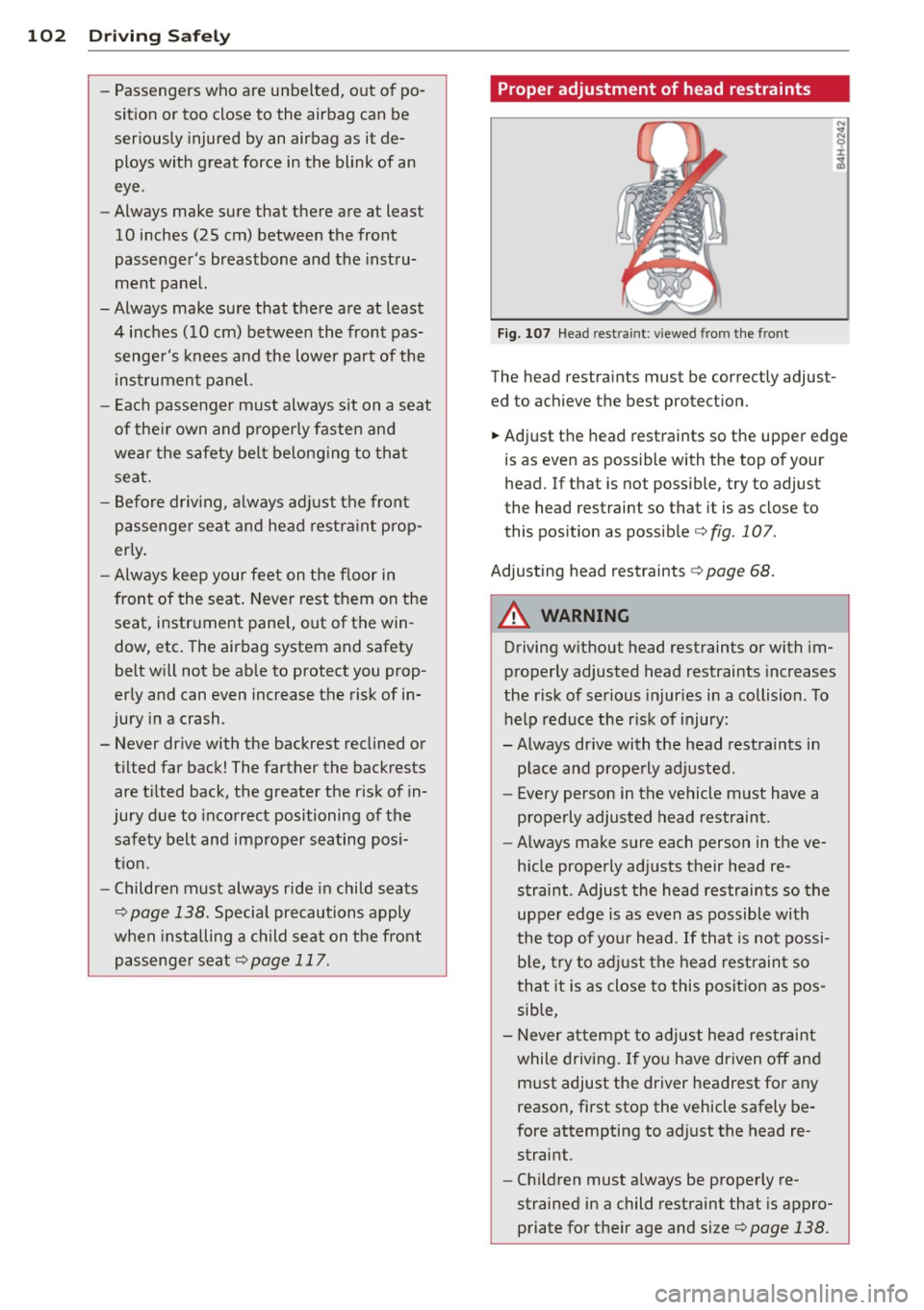
102 Driving Safely
-Passengers who are unbelted, out of po
sition or too close to the airbag can be
seriously injured by an airbag as it de
ploys with great force in the blink of an
eye .
- Always make sure that there are at least
10 inches (25 cm) between the front
passenger's breastbone and the instru
ment panel.
-Always make sure that there are at least 4 inches (10 cm) between the front pas
senger's knees and the lower part of the
instrument panel.
- Each passenger must always sit on a seat
of their own and properly fasten and
wear the safety belt belonging to that seat.
- Before driving, always adjust the front
passenger seat and head restraint prop
erly.
- Always keep your feet on the floor in
front of the seat. Never rest them on the
seat, instrument panel, out of the win
dow, etc. The airbag system and safety
belt will not be able to protect you prop
erly and can even increase the risk of in
jury in a crash.
- Never drive with the backrest reclined or tilted far back! The farther the backrests are tilted back, the greater the risk of in
jury due to incorrect positioning of the
safety belt and improper seating posi
tion.
- Children must always ride in child seats
¢ page 138. Special precautions apply
when installing a child seat on the front
passenger seat
¢ page 117.
Proper adjustment of head restraints
Fig. 107 Head restra int: v iewed from the front
The head restraints must be correctly adjust
ed to achieve the best protection.
.,. Adjust the head restraints so the upper edge
is as even as possible with the top of your
head. If that is not possible, try to adjust
the head restraint so that it is as close to
this position as possible
c:;, fig . 10 7.
Adjusting head restraints¢ page 68.
A WARNING
Driving without head restraints or with im
properly adjusted head restraints increases
the risk of serious injuries in a collision. To
help reduce the risk of injury:
- Always drive with the head restraints in
place and properly adjusted.
- Every person in the vehicle must have a
properly adjusted head restraint.
- Always make sure each person in the ve
hicle properly adjusts their head re
straint . Adjust the head restraints so the
upper edge is as even as possible with
the top of your head. If that is not possi
ble, try to adjust the head restraint so
that it is as close to this position as pos
sible,
- Never attempt to adjust head restraint
while driving. If you have driven off and
must adjust the driver headrest for any reason, first stop the vehicle safely be
fore attempting to adjust the head re
straint.
- Children must always be properly re
strained in a child restraint that is appro
priate for their age and size
c:;, page 138.
Page 105 of 244
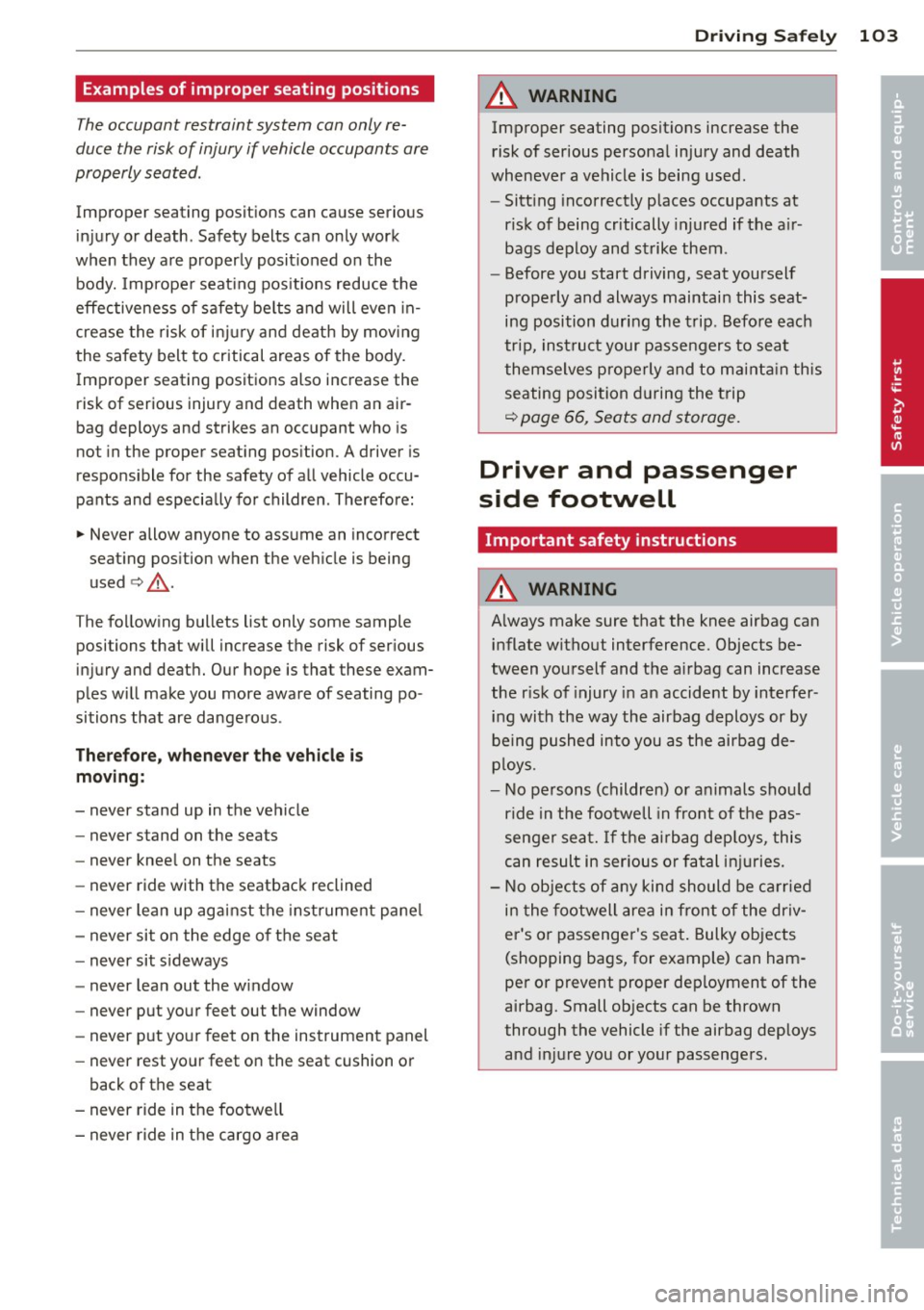
Examples of improper seating positions
The occupant restraint system can only re
duce the risk of injury if vehicle occupants are
properly seated.
Improper seating positions can cause serious
injury or death. Safety belts can only work
when they are properly posit ioned on the
body. Improper seating positions reduce the
effectiveness of safety belts and will even in
crease the risk of injury and death by moving
the safety belt to critical areas of the body.
Improper seating positions also increase the
risk of serious injury and death when an air
bag deploys and strikes an occupant who is
not in the proper seating position. A driver is
responsible for the safety of all vehicle occu
pants and especially for children . Therefore :
... Never allow anyone to assume an incorrect
seating position when the vehicle is being used
c> _& .
The following bullets list only some sample
positions that will increase the risk of serious
injury and death. Our hope is that these exam
ples will make you more aware of seating po
sitions that are dangerous .
Therefore, whenever the vehicle is
moving:
- never stand up in the vehicle
- never stand on the seats
- never kneel on the seats
- never ride with the seatback reclined
- never lean up against the instrument panel
- never sit on the edge of the seat
- never sit sideways
- never lean out the window
- never put your feet out the window
- never put your feet on the instrument panel
- never rest your feet on the seat cushion or
back of the seat
- never ride in the footwell
- never ride in the cargo area
Driving Safely
A WARNING
Improper seating positions increase the
risk of serious personal injury and death
whenever a vehicle is being used.
- Sitting incorrectly places occupants at
risk of being critically injured if the air
bags deploy and strike them .
- Before you start driving, seat yourself
properly and always maintain this seat
ing position during the trip . Before each
trip, instruct your passengers to seat
themselves properly and to maintain this
seating position during the trip
c> page 66, Seats and storage .
Driver and passenger
side footwell
Important safety instructions
A WARNING
Always make sure that the knee airbag can
inflate without interference. Objects be
tween yourself and the airbag can increase
the risk of injury in an accident by interfer
ing with the way the airbag deploys or by
being pushed into you as the airbag de
ploys.
- No persons (children) or animals should
ride in the footwell in front of the pas
senger seat. If the airbag deploys, this
can result in serious or fatal injuries.
- No objects of any kind should be carried
in the footwell area in front of the driv
er's or passenger's seat. Bulky objects
(shopping bags, for example) can ham
per or prevent proper deployment of the
airbag. Small objects can be thrown
through the vehicle if the airbag deploys
and injure you or your passengers.
-
103
•
•
Page 106 of 244

104 Driving Safel y
Pedal area
The pedals must always be free to move and
must never be interfered with by a floor mat
or any other object.
• Make sure that all pedals move freely w ith
out interference.
• Make sure that noth ing prevents all pedals
from returning to their orig inal positions.
Only use floor mats that leave the pedal area
free and can be secured w ith floor mat fasten
e rs .
If a brake circuit fails, increased brake pedal
travel is required to bring the vehicle to a full
stop .
A WARNING ,_
Pedals that cannot move freely can cause
loss of vehicle control and increase the r is k
of serious injury.
- Never place any objects in the driver's
footwell. An object could get into the
peda l area and interfere w ith pedal func
tion . In case of sudden braking or an ac
cident, you would not be able to brake or
accelerate!
-Always make sure that nothing can fa ll
or move into the driver's footwell.
Floor mats on the driver side
Always use floor mats that can be securely attached to the floor mat fasteners and do
not interfere with the free movement of the
pedals.
• Make sure that the f loor mats are proper ly
secured and cannot move and interfere with
the pedals
q .&_ .
Use only floor mats that leave the pedal area
unobstructed and that are firmly secured so
that they cannot s lip out of position. You can
obtain suitable floor mats from your author ized Audi dealer .
A WARNING
Pedals that cannot move free ly can result
in a loss of vehicle control and increase the
risk of ser ious personal injury.
- Always make sure that floor mats are
properly secured.
- Never p lace or install floor mats or other
floor coverings in the vehicle that cannot be properly secured in place to prevent
them from slipping and interfer ing with
the peda ls or the ab ility to control the
veh icle.
- Never p lace or install floor mats or other
f loor coverings on top of al ready instal
led floor mats. Add itiona l floor mats and
other coverings will red uce the size of
the peda l area and interfere w ith the
pedals.
- Always properly reinstall and secure floor
mats that have been taken out for clean
ing.
- Always make sure that objects cannot
fall into the driver footwell while the ve
h icle is moving. Objects can become
trapped under the brake pedal and accel
erator pedal causing a loss of vehicle
control.
Stowing luggage
Loading the luggage compartment
All luggage and other objects must be prop erly stowed and secured in the luggage com
partment.
Loose items in the luggage compa rtment can
shift suddenly, changing vehicle handling
charac teristics. Loose items can also increase
the risk of serious personal injury in a sudden
vehicle maneuver or in a collision.
In a collision, the laws of physics mean that
even smaller items that are loose in the vehi
cle will become heavy missi les that can cause
serious injury. Items in the vehicle possess en
ergy which vary with vehicle speed and the
weight of the item. Vehicle speed is the most
significant factor.
Page 107 of 244
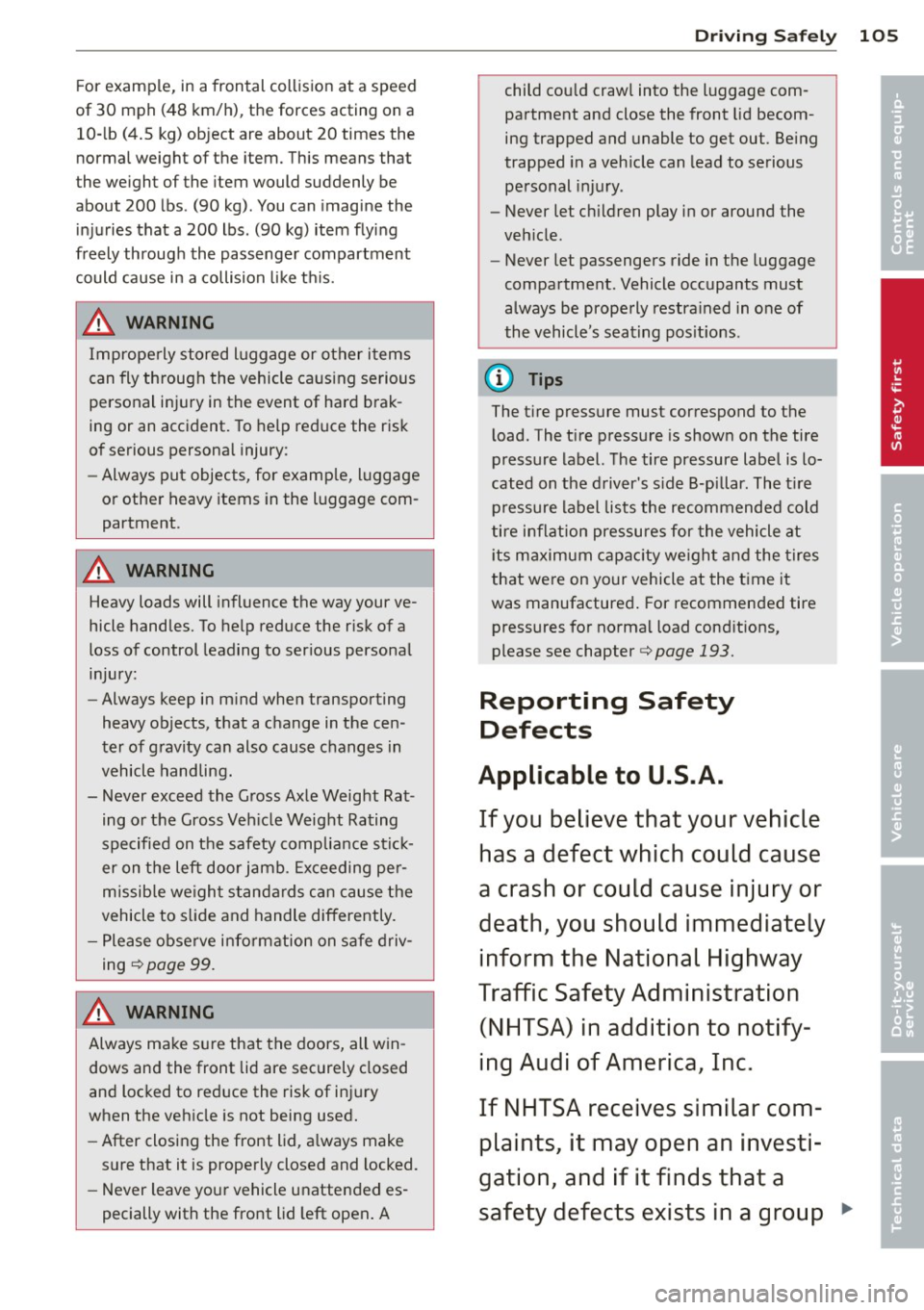
For example, in a frontal collision at a speed
of 30 mph (48 km/h), the forces acting on a 10- lb (4.5 kg) object are about 20 times the
norma l weight of the item. This means that
the we ight of the item would suddenly be
about 200 lbs . (90 kg) . You can imagine the
in juries that a 200 lbs. (90 kg) item flyi ng
freely throug h the pass enge r compartment
could cause in a collision li ke t his.
_& WARNING
Imprope rly stored luggage or other items
can fly through the vehicle ca using se rious
personal in jury in the event of har d brak
ing or an acc ident . To help reduce the r is k
of serious personal injury :
- Always put objects, for examp le, luggage
o r othe r heavy items in the luggage com
partment.
_& WARNING
Heavy loads will influence the way your ve
hicle handles. To help reduce the r isk of a
loss of control leading to ser ious personal
injury:
- Always keep in m ind whe n transporting
heavy objects, t hat a change in t he cen
ter of g ravity can also cause c hanges in
vehicl e handling.
- Never exceed the G ross Ax le Weight Ra t
ing or t he Gross Veh icle Weight Rating
spe cified on t he safety compliance stic k
er on t he left door jamb. Exceeding pe r
missib le we igh t standa rds can cause the
vehicle to s lide and handle differently.
- Please observe info rm atio n on s afe driv
ing
C? page 99.
_& WARNING , ~ ~
Always make su re that the doors, all win
dows and the front lid are securely closed
an d locked to red uce the risk of in jury
when the veh icle is not being used .
- After closing the front lid, a lways make
s u re that it is properly closed and locked .
- Never leave you r vehicle unatten ded es
pecially with the front lid left open . A
Dr iving S afel y 105
child cou ld craw l into the luggage com
pa rtment and close the front lid becom
ing trapped and unable to get out. Be ing
trapped in a veh icle can lead to se rious
pe rsonal injury .
- Never let ch ildren play i n or around the
veh icle .
- Never let passengers ride in t he luggage
compartment . Vehicle occupants must
always be prope rly restra ined in one of
the vehicle 's seating pos it ions .
(D Tips
The t ire pressure must correspond to the
l oad. The t ire press ure is show n on the tire
p ressure label. The tire pressure label is lo
cated on the d river 's s ide B-pillar. The t ire
pressure label lists the recommended cold
tire inflation pressures for the vehicle at
it s m aximum c apac ity we igh t a nd the tires
that we re on your vehicle at the t ime it
was manufacture d. For recommended tire
pressures fo r normal load cond it ions,
please see chapter c::> page 193.
Reporting Safety
Defects
Applicable to U.S.A.
If you believe that your vehi cle
ha s a defect which could cau se
a crash or could caus e injury or
death, you should immediately inform the National Highway
Traffic Safety Administration (NHTSA) in addition to notify
ing Audi of Amer ica , Inc .
If NHTSA receives similar com plaints, it may open an investi
gation , and if it finds that a
safet y defect s exists in a group .,.
•
•
Page 108 of 244
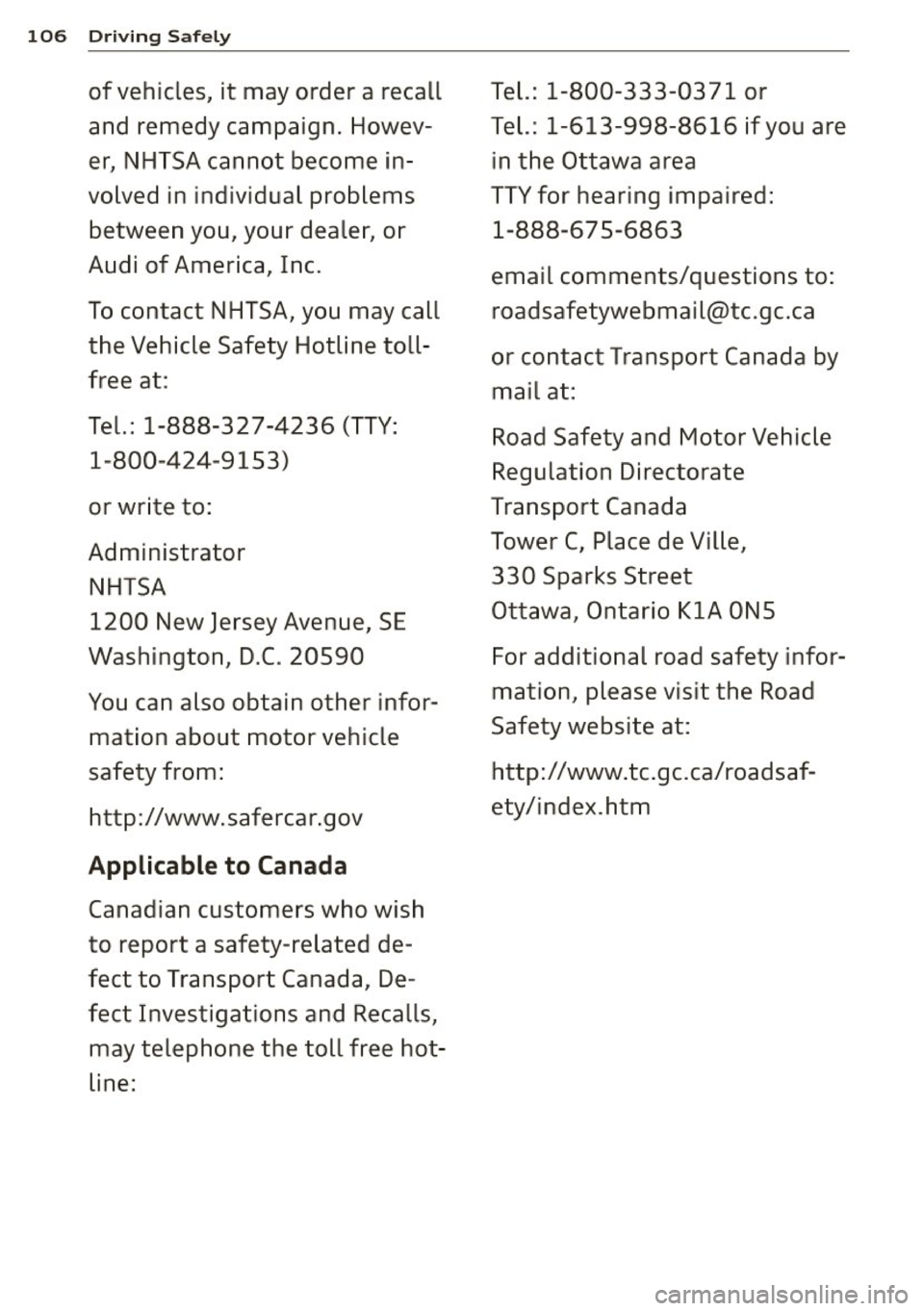
106 Driving Safely
of vehicles, it may order a recall
and remedy campaign. Howev
er, NHTSA cannot become in
volved in individual problems
between you, your dealer, or
Audi of America, Inc.
To contact NHTSA, you may call
the Vehicle Safety Hotline toll
free at:
Tel.: 1-888-327-4236 (TTY:
1-800-424-915 3)
or write to:
Administrator NHTSA 1200 New Jersey Avenue, SE
Washington, D.C. 20590
You can also obtain other infor mation about motor vehicle
safety from:
http://www.safercar.gov
Applicable to Canada
Canadian customers who wish
to report a safety-related de
fect to Transport Canada, De
fect Investigations and Recalls,
may telephone the toll free hot
line: Tel.
: 1-800-333-0371 or
Tel. : 1-613-998-8616 if you are
in the Ottawa area
TTY for hearing impaired:
1-888-67 5-6863
email comments/questions to: [email protected]
or contact Transport Canada by mail at:
Road Safety and Motor Vehicle
Regulation Directorate
Transport Canada
Tower C, Place de Ville,
330 Sparks Street
Ottawa, Ontario
KlA ONS
For additional road safety infor
mation, please visit the Road
Safety website at:
http://www.tc.gc.ca/roadsaf
ety/index.htm
Page 109 of 244
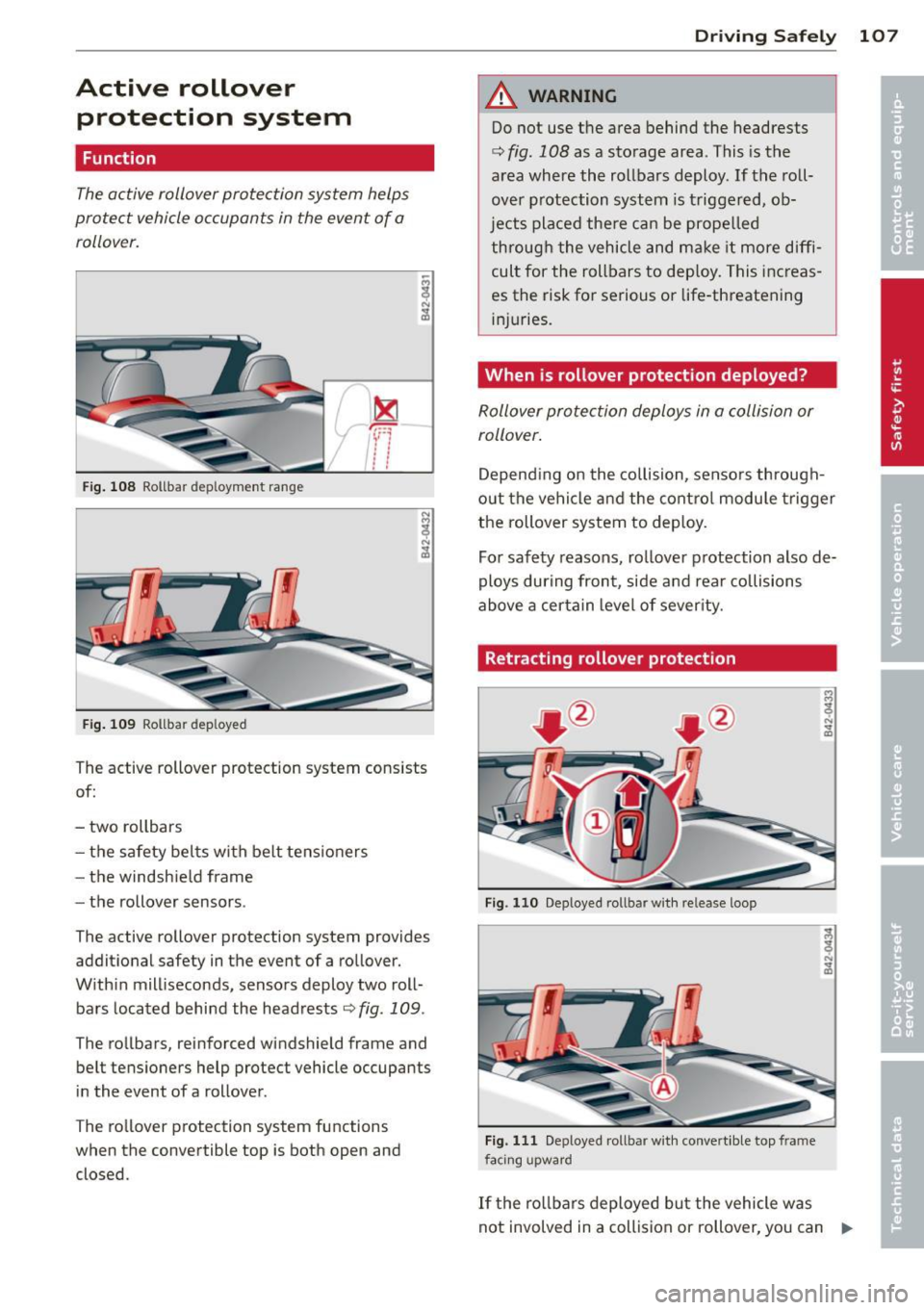
Active rollover protection system
Function
The active rollover protect ion system helps
protect vehicle occupants in the event of a
rollov er.
I~
l
I
~
l
t1
! t
Fig. 108 Rollbar depl oyment range
Fig. 109 Rollbar dep loyed
The active rollover protection system consists
of:
- two rollbars
- the safety belts with belt tensioners
- the windshield frame
- the rollover sensors .
The active rollover protection system provides
additional safety in the event of a rollover.
W ith in mill iseconds, sensors deploy two roll
bars located behind the headrests
¢fig . 109 .
The rollbars, reinforced windshield frame and
belt tensioners help protect vehicle occupants
in the event of a rollover.
T he rollover protection system functions
when the convertible top is both open and
closed.
Driving Safely 107
A WARNING
Do not use the area behind the headrests
¢ fig. 108 as a storage area . This is the
area where the rollbars deploy .
If the roll
over protection system is triggered, ob
jects placed there can be propelled
through the vehicle and make it more diffi
cult for the rollbars to deploy. This increas
es the risk for serious or life -threatening
in juries.
When is rollover protection deployed?
Rollover protection deploys in a collision or
rollover .
Depending on the collision, sensors through
out the vehicle and the control module trigge r
the rollover system to deploy.
For safety reasons, rollover protection also de
ploys during front , side and rear collisions
above a certa in level of severity.
Retracting rollover protection
Fig. 110 Dep loyed roll bar w ith re lease loop
Fig . 1 11 Dep loyed rollb ar with conve rtible top fram e
facing upwar d
If the rollbars deployed but the vehicle was
not involved in a collision or rollover, you can .,.
Page 110 of 244
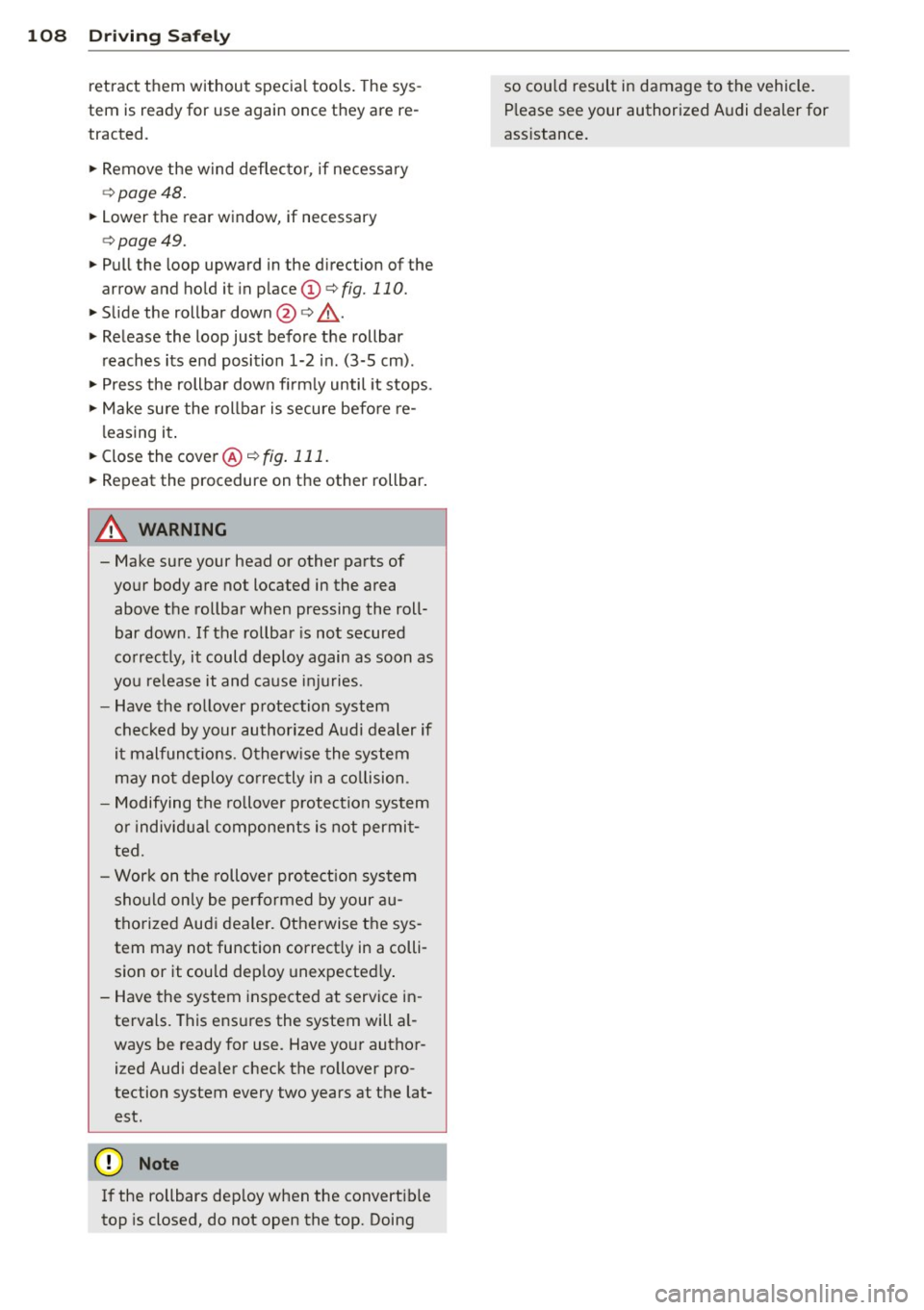
108 Driving Safely
retract them without special tools. The sys
tem is ready for use again once they are re
tracted.
"" Remove the wind deflector, if necessary
¢ page 48.
""Low er the rear window, if necessary
¢page 49.
""Pull the loop upward in the direction of the
arrow and hold it in place
(D ¢ fig. 110.
"" Slide the rollbar down@¢ _A.
"" Release the loop just before the rollbar
reaches its end position 1-2 in. (3-5 cm) .
""Press the rollbar down firmly until it stops.
"" Make sure the rollbar is secure before re
leasing it.
""Close the cover @¢
fig. 111.
"" Repeat the procedure on the other rollbar.
A WARNING
-
-Make sure your head or other parts of
your body are not located in the area
above the rollbar when pressing the roll
bar down. If the rollbar is not secured
correctly,
it could deploy again as soon as
you release it and cause injuries.
- Have the rollover protection system
checked by your authorized Audi dealer if
it malfunctions. Otherwise the system
may not deploy correctly in a collision .
- Modifying the rollover protection system
or individual components is not permit
ted.
- Work on the rollover protection system
should only be performed by your au
thorized Audi dealer. Otherwise the sys
tem may not function correctly in a colli
sion or it could deploy unexpectedly.
- Have the system inspected at service in
tervals. This ensures the system will al
ways be ready for use. Have your author ized Audi dealer check the rollover pro
tection system every two years at the lat
est.
If the rollbars deploy when the convertible
top is closed, do not open the top. Doing so could result in damage to the vehicle.
Please see your authorized Audi dealer for
assistance.